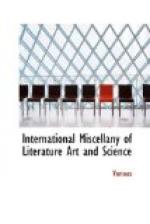In poetry, as in prose, he was eminently successful in the metaphysical treatment of the passions. Hia poems are constructed with wonderful ingenuity, and finished with consummate art. They display a somber and weird imagination, and a taste almost faultless in the apprehension of that sort of beauty which was most agreeable to his temper. But they evince little genuine feeling, and less of that spontaneous ecstasy which gives its freedom, smoothness and naturalness to immortal verse. His own account of the composition of “The Raven,” discloses his methods—the absence of all impulse, and the absolute control of calculation and mechanism. That curious analysis of the processes by which he wrought would be incredible if from another hand.
He was not remarkably original in invention. Indeed some of his plagiarisms are scarcely paralleled for their audacity in all literary history: For instance, in his tale of “The Pit and the Pendulum,” the complicate machinery upon which the interest depends is borrowed from a story entitled “Vivenzio, or Italian Vengeance,” by the author of “The First and Last Dinner,” in “Blackwood’s Magazine.” And I remember having been shown by Mr. Longfellow, several years ago, a series of papers which constitute a demonstration that Mr. Poe was indebted to him for the idea of “The Haunted Palace,” one of the most admirable of his poems, which he so pertinaciously asserted had been used by Mr. Longfellow in the production of his “Beleaguered City.” Mr. Longfellow’s poem was written two or three years before the first publication of that by Poe, and it was during a portion of this time in Poe’s possession; but it was not printed, I believe, until a few weeks after the appearance of “The Haunted Palace.” “It would be absurd,” as Poe himself said many times, “to believe the similarity of these pieces entirely accidental.” This was the first cause of all that malignant criticism which for so many years he carried on against Mr. Longfellow. In his “Marginalia” he borrowed largely, especially from Coleridge, and I have omitted in the republication of these papers, numerous paragraphs which were rather compiled than borrowed from one of the profoundest and wisest of our own scholars.[D]
[Footnote D: I have neither space, time, nor inclination for a continuation of this subject, and I add but one other instance, in the words of the Philadelphia “Saturday Evening Post,” published while Mr. Poe was living:
“One of the most remarkable plagiarisms was perpetrated by Mr. Poe, late of the Broadway Journal, whose harshness as a critic and assumption of peculiar originality make the fault in his case more glaring. This gentleman, a few years ago, in Philadelphia, published a work on Conchology as original, when in reality it was a copy, near verbatim, of ‘The Text-book of Conchology, by Captain Thomas Brown,’ printed in Glasgow in 1833, a duplicate of which we have in our library, Mr. Poe actually took out a copyright




